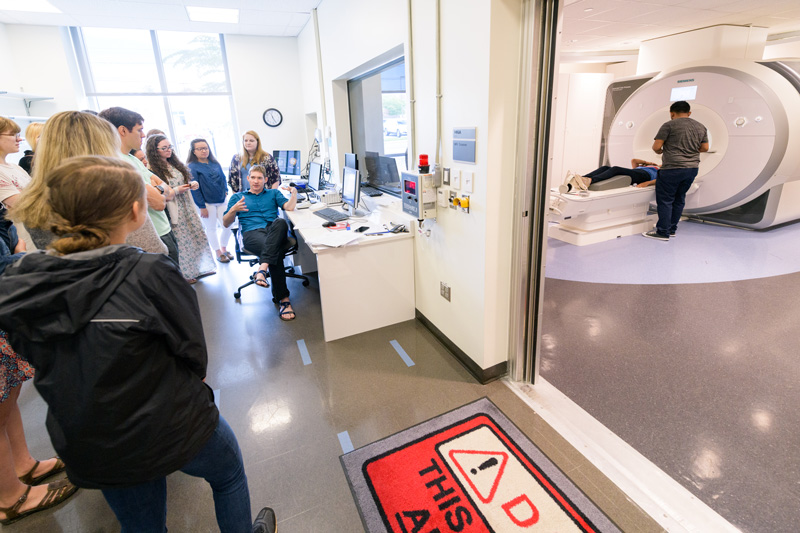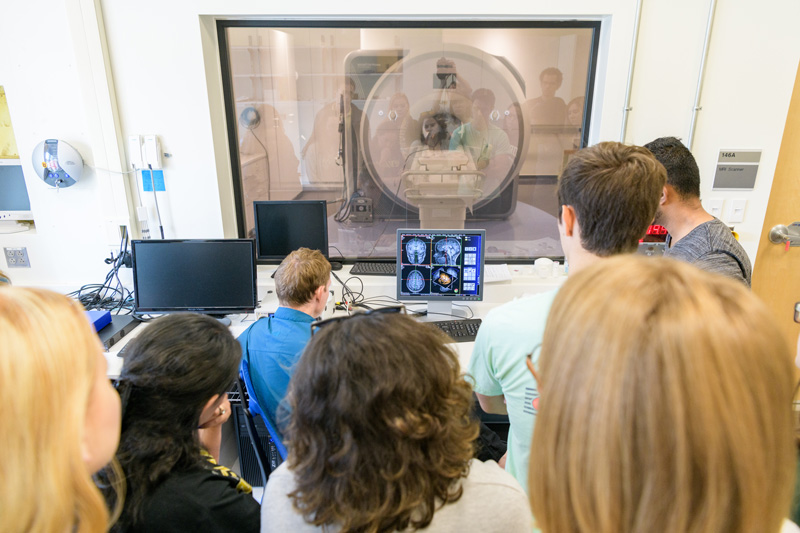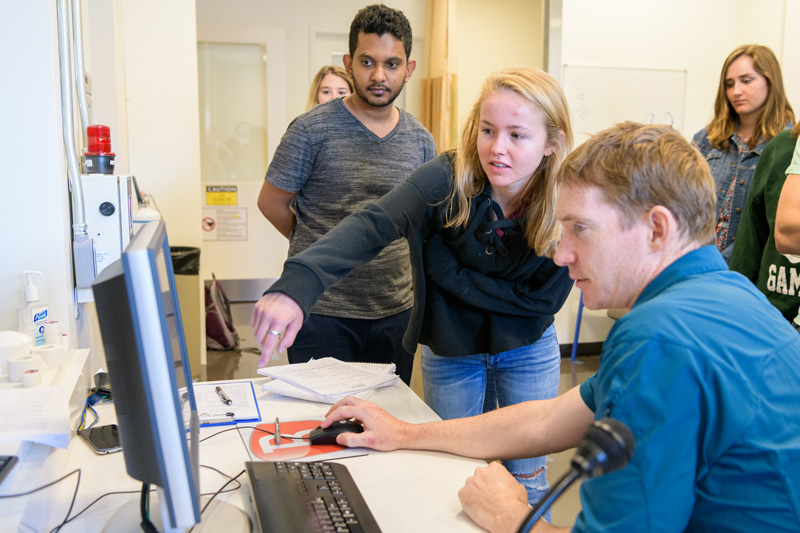

Exploring the brain
Photo by Evan Krape June 28, 2018
Summer ‘camp’ students have neuroscience on their mind
Jennifer Macias, a psychology student at California State University, Monterey Bay, has known since age 15 that she wanted to pursue a doctoral degree and conduct research in neuroscience.
Diagnosed at the time with a sleep disorder, she learned techniques to cope with the condition. But, she said, she also found something else that was helpful: Learning more about how the brain works.
“I got very interested in sleep and the brain,” Macias said while attending the University of Delaware’s Summer Workshop in Cognitive and Brain Sciences this June. “I’ve been really fascinated by brain science ever since.”
At the intensive two-week program, known more informally as Brain Camp, Macias was one of 15 undergraduate students from eight states across the country who joined two UD students to explore academic, research and career options in the field of cognitive neuroscience.
Faculty members from a variety of colleges and departments at the University led sessions that included lectures, hands-on activities and visits to campus research labs. Brain Camp, offered for the first time in the summer of 2017, is supported by a grant from the National Science Foundation’s Established Program to Stimulate Competitive Research (EPSCoR).
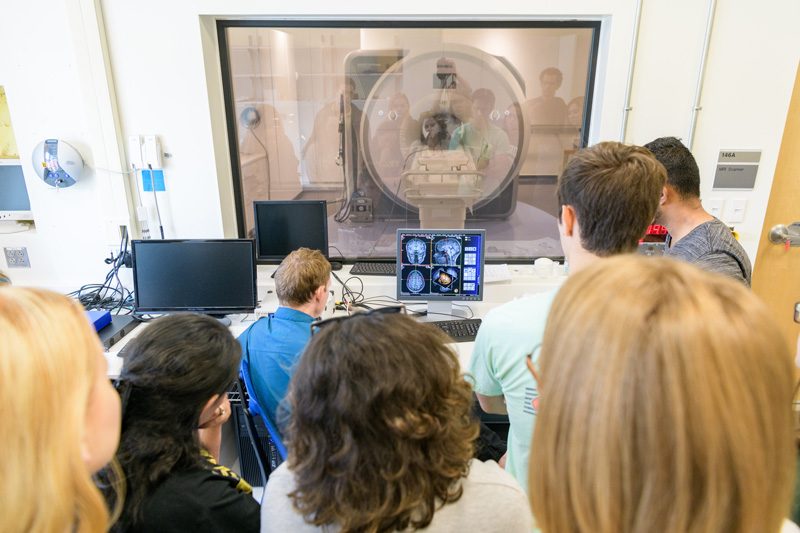
The program was led by Jared Medina, assistant professor in the Department of Psychological and Brain Sciences, which houses UD’s neuroscience program. Medina was the principal investigator on the EPSCoR grant, which allows students to attend free of charge.
Participants, selected from a large pool of applicants, were identified as students with a broad range of backgrounds whose academic curiosity and experiences made them top candidates for developing research skills in cognitive and brain science.
Not all were as clear about their eventual career path as Macias, but most said they were planning to go on to graduate school, even if they hadn’t yet narrowed down a field of study. Many said their schools didn’t have specific neuroscience programs or research facilities as extensive as UD’s.
Four of the students are staying on at UD for the rest of the summer to conduct undergraduate research.
“This has been an amazing experience, to have access to the breadth of knowledge I got from this program and to see the resources available for research here,” said Laura Pazos, a biology major at the University of Southern Mississippi, who is considering graduate studies in neuroscience or cognitive science.
“This helped me broaden my interests when I think about my future. Reading about it [research in different areas of brain science] is one thing, but once I saw some of the work firsthand and got to hear the researchers talking about what they do, I was fascinated.”
Topics covered during the program included language development, infant cognition, brain plasticity and disorders, the neuroscience of vision, spatial memory and the effects of concussion on cognitive function.
For the session on brain imaging, students spent a morning with the functional magnetic resonance imaging (fMRI) instrument in the University’s Center for Biomedical and Brain Imaging. Several participants volunteered to have their brain scanned as a demonstration of both structural MRI, which takes a static image of the brain, and functional MRI, which shows brain activity.
Students gathered around monitors to look at the images being taken, as Keith Schneider, associate professor of psychological and brain sciences, pointed to parts of the brain.
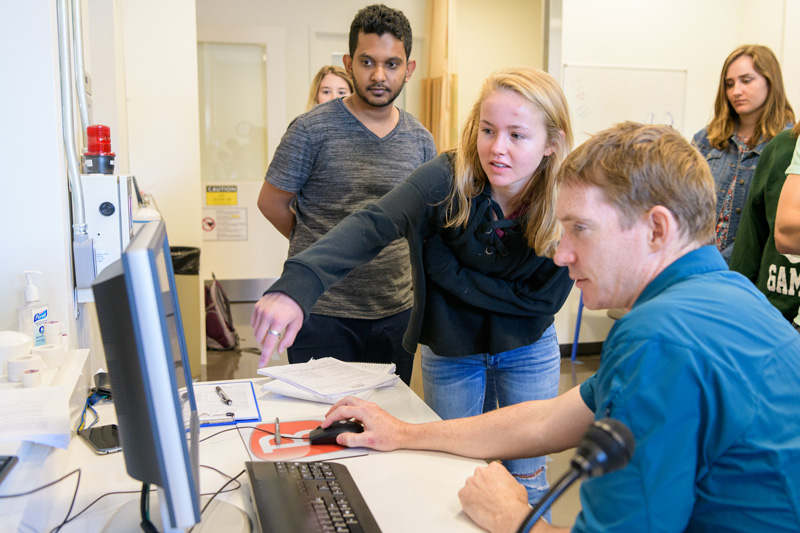
“It’s pretty impressive to see your brain for the first time,” he said, explaining that its structure varies among individuals. “It’s always been there, but you’ve never seen it. And everything you learn changes your brain in some way.”
One of the last days of Brain Camp took students to the College of Health Sciences Human Performance Lab, where athletes are given a series of baseline tests on various aspects of cognitive function. Those results can then be used in the future to assess the effects of a possible concussion.
The session was taught by Tom Kaminski, professor of kinesiology and applied physiology, who has been conducting research on head impacts in soccer for 20 years.
Students tried out the various assessments, including tests to evaluate their balance and gait. In one assessment, each walked heel-to-toe along a line on the floor, turning and walking as quickly as possible while their times were recorded. They then repeated the test while spelling words backward or counting backward, measuring how those mental efforts distracted them and slowed their walking.
In a person who’s had a concussion, they were told, those distracting effects are generally much more pronounced.
These kinds of demonstrations of research in action were especially interesting to Kayla Aikins, a neuroscience student at the University of Nevada at Reno who has conducted undergraduate research on visual perception.
“I’m pre-med, so I especially enjoyed the clinical sessions” at Brain Camp, Aikins said. “The speakers have all been fantastic, and I’ve seen a lot of different aspects of research.”
For Aaron Halvorsen of the University of Nebraska at Lincoln, the UD program helped him learn more about the field of neuroscience, as he explores different possibilities for graduate school.
“My school doesn’t have a neuroscience major, so I feel like this has really helped me learn more about my options,” he said. “It was also great to learn what’s new in the field.”
Contact Us
Have a UDaily story idea?
Contact us at ocm@udel.edu
Members of the press
Contact us at 302-831-NEWS or visit the Media Relations website

